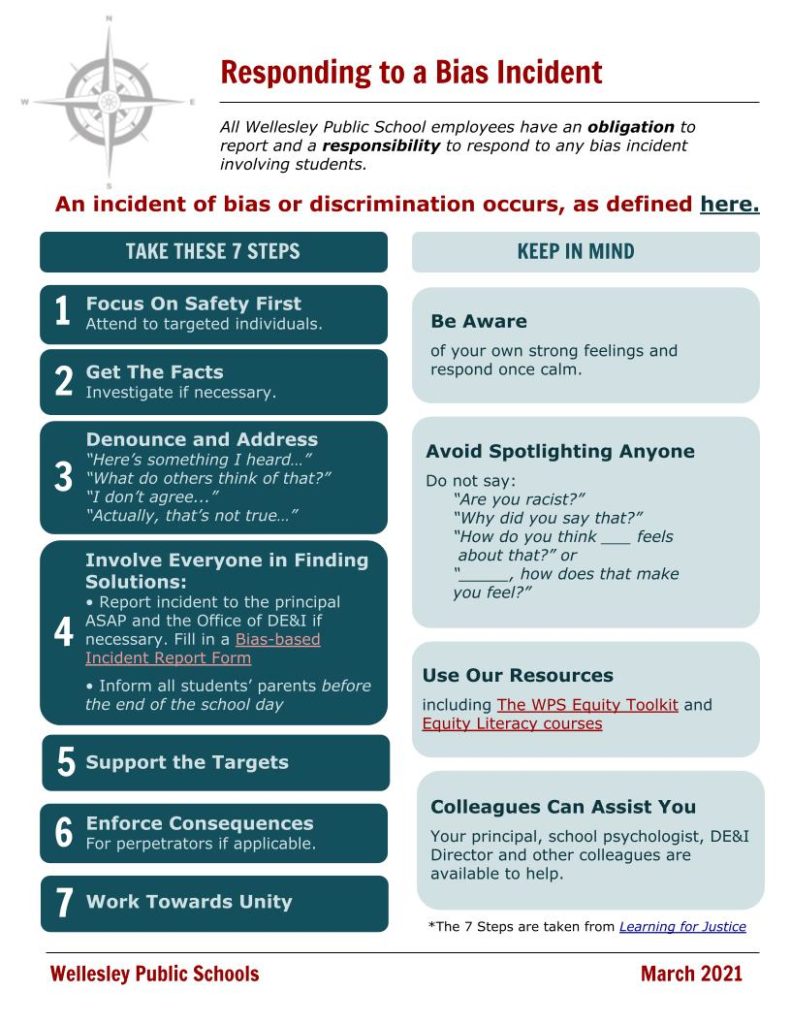Bias-based incidents are dangerous and disruptive to any school community. These incidents, when they occur, can deeply challenge any school community’s climate of belonging. Keep this in mind: “A bias incident does not define a school. It is, in many ways, a test of the school’s culture and climate” (). How we plan for, address, and recover from such incidents will determine what progress we will make toward ensuring an inclusive community where respect for human differences is a lived-out core value.
Review our expectations for . You can report a bias incident using the .

FAQs
What is a bias incident?
A bias incident is any conduct that demonstrates conscious or unconscious bias that targets, and causes harm to, individuals or groups because of their race, color, sex, age, gender, gender identity, religion, national origin, limited English proficiency, sexual orientation, disability, housing status, or pregnancy or pregnancy-related conditions. Bias-based behavior can also be described as treating someone differently that causes harm because of their race, color, sex, age, gender, gender identity, religion, national origin, limited English proficiency, sexual orientation, disability, housing status, or pregnancy or pregnancy-related conditions.
Words and expression are essential to the educational goals and processes of our schools, and students are expected to build their ability to express their opinions, persuade others, and learn from others through debate and discussion. But we also understand that words can demonstrate bias, embody hatred, and cause harm.
Student speech and expression targeted at other students, faculty, administrators, or staff; or occurring on school grounds or during school-sponsored on-line instruction; on school transportation or while a student is en route to or from school; during a school-sponsored event, activity, trip, or competition; or while representing the school in the larger community; can be considered a bias incident when: the speech or expression targets others because of their race, color, religious creed, national origin, sex, gender identity, sexual orientation, genetic information, pregnancy, or disability; and the speech or expression threatens another individual or group; harasses, abuses, or bullies another individual or groups; risks violence by way of retaliation or incitement; uses racial, sexual, or other odious epithets; uses symbols that operate as epithets, such as swastikas or burning crosses; is profane or lewd and occurs on school grounds or during a school activity or event; poses a significant risk of disruption to, or interference with, the pedagogical objectives and educational mission of a classroom, program, school, or district; or endangers school, student, or public safety.
What are some examples of bias incidents?
When a teacher or coach disciplines a student more often or more harshly because of their sex or gender identity; When a student uses a slur or epithet toward another student based on their race; When a student draws a swastika or writes an ethnic slur on a bathroom wall; When a student taunts a staff member because of their disability; When students bully a transgender student by mimicking and mocking the way they may walk, talk, or dress; When a student who is pregnant is called a lewd name in the school hallway; While on the way to a game, when members of a sports team mock and harass one of their members because of the target’s sexual orientation; While at a debate tournament, when students taunt the students of a competitor school by imitating their cultural norms, accent, or language.
What are some non-examples of bias incidents?
When a student wears a political candidate’s button to school; When a teacher encourages a political discussion in class and students disagree with each other; When a student uses profane language but it is not targeted at someone because of their race, sex, religion, etc.
What is the difference between bias-based incidents and hate crimes?
Only law enforcement can determine whether something is a hate crime. Hate crimes are motivated by bias, but they also include violence, threats, or the destruction of property. Please report possible hate crimes to the police, or ask school personnel to assist you in contacting the police.
How can I report a bias-based incident?
The first step is to contact your school principal or school leadership team. These staff members will be the first point of contact, and be responsible for investigating the initial report, and making recommendations for resolution.
Why is it important to report a bias-based incident?
By reporting a bias-based incident, the appropriate personnel can respond accordingly and provide support, intervention, or education to end the behavior. In addition, reporting bias-based incidents informs systemic school supports and interventions.
Can bias be eliminated?
Bias-based incidents can be reduced and potentially eliminated with proper supports, interventions, and education. When bias occurs, the first priority is the student’s safety. If a situation arises where you feel comfortable speaking up, here are a few strategies to address bias-based behaviors:Share how the comment or behavior makes you feel;Tell the person directly their comment or behavior is concerning or hurtful; Ask the person why they made that comment or engaged in that specific behavior.
To report an incident, contact the appropriate school personnel within your school or department first. As a learning community, please familiarize yourself with our policies, in order to be a first responder, should the need arise.
As we build awareness of bias-based behaviors in our learning communities, we need to ensure that all students from Pre-K-12 have developmentally appropriate avenues for understanding what constitutes bias-based behaviors, and what systems and structures exist for reporting such incidents, and the appropriate consequences. Below are some resources on bias:
Updated 8/22
